
The Noctuidae, commonly known as owlet moths, cutworms or armyworms, are a family of moths. They're considered the most controversial family in the superfamily Noctuoidea because many of the clades are constantly changing, along with the other families of the Noctuoidea. It was considered the largest family in Lepidoptera for a long time, but after regrouping Lymantriinae, Catocalinae and Calpinae within the family Erebidae, the latter holds this title now. Currently, Noctuidae is the second largest family in Noctuoidea, with about 1,089 genera and 11,772 species. However, this classification is still contingent, as more changes continue to appear between Noctuidae and Erebidae.

Notodontidae is a family of moths with approximately 3,800 known species. The family was described by James Francis Stephens in 1829. Moths of this family are found in all parts of the world, but they are most concentrated in tropical areas, especially in the New World.

Orgyia antiqua, the rusty tussock moth or vapourer, is a moth in the family Erebidae.

Pantheinae is a small subfamily of moth family Noctuidae. It used to be considered a family, under the name Pantheidae.

Chrysodeixis eriosoma, the green garden looper, is a moth of the family Noctuidae. Mostly cosmopolitan in distribution, it is a pest in Japan, China, India, Sri Lanka, the Malay Peninsula and Australasia. It is present in Hawaii and recorded as an incursion in mainland North America and Russia. It is morphologically identical to Chrysodeixis chalcites and the two may be sibling species.

Acronicta americana, the American dagger moth, is a moth of the family Noctuidae. It was originally described by Thaddeus William Harris in 1841 and is native to North America.

Mythimna separata, the northern armyworm, oriental armyworm or rice ear-cutting caterpillar, is a moth of the family Noctuidae. It is found in China, Japan, South-east Asia, India, eastern Australia, New Zealand, and some Pacific islands. It is one of the major pests of maize in Asia. The species was first described by Francis Walker in 1865.
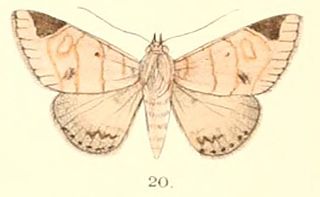
Dordura is a monotypic moth genus of the family Noctuidae erected by Frederic Moore in 1882. Its only species, Dordura aliena, was first described by Francis Walker in 1865. It is found in the Indian subregion, Sri Lanka, Myanmar, Thailand, Peninsular Malaysia, Sumatra, Borneo and New Guinea.
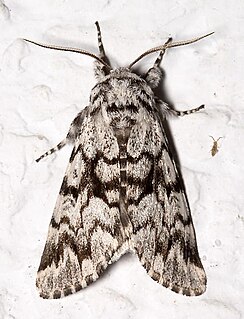
Panthea acronyctoides, the black zigzag or tufted spruce caterpillar, is a moth of the family Noctuidae. The species was first described by Francis Walker in 1861. It is found in North America from Newfoundland to British Columbia and adjacent northern states, south in the west to Colorado, south in the east to New England and Kentucky.
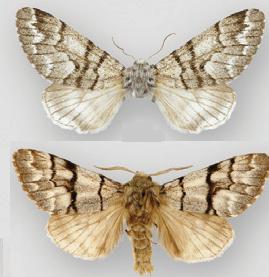
Panthea furcilla is a species of moth of the family Noctuidae. It is found across the boreal forest region of Canada west to the Rocky Mountains, and in the eastern parts of the United States, from Maine to Florida, west to Texas, north to Indiana and Ohio.

Mythimna decisissima is a moth of the family Noctuidae first described by Francis Walker in 1856. It is found from India across south-east Asia including Hong Kong, Japan, Taiwan and Australia in Queensland and New South Wales. It is also present in South Africa.

Panthea gigantea is a moth of the family Noctuidae. It is found throughout much of the warmer and drier regions of western North America from south-central British Columbia, south to the state of Durango in Mexico and from the Black Hills of South Dakota, western Nebraska and the Texas Panhandle west to Washington, Oregon and the coast of California.

Panthea apanthea is a moth of the family Noctuidae. The species is found in three areas of the south-western United States, Coconino County and Apache County in Arizona, and El Paso County in east-central Colorado.
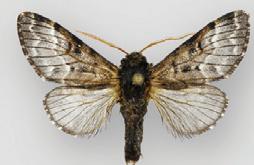
Panthea reducta is a moth of the family Noctuidae. It has been collected at an elevation of 1,800 m (5,900 ft) in a Hispaniolan pine forest in Sierra de Bahoruco National Park in the Dominican Republic.

Panthea judyae is a moth of the family Noctuidae. It has been collected in the Mogollon Mountains and Big Burro Mountains of south-western New Mexico, the Huachuca Mountains of south-eastern Arizona, and the Sierra Madre Occidental of northern Mexico, at elevations of 1800–2400 m.
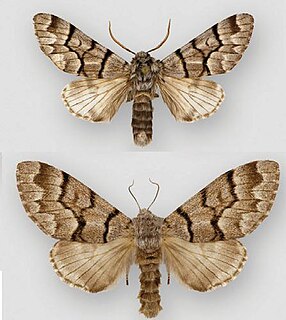
Panthea guatemala is a moth of the family Noctuidae. It has been collected in the mountains of Guatemala and the states of Oaxaca and Chiapas in adjacent southern Mexico at elevations of 1580–1850 m.

Panthea greyi is a moth of the family Noctuidae. It has been collected in the mountains of Arizona, New Mexico, Colorado and southern Utah, at elevations of 1524–2545 m.
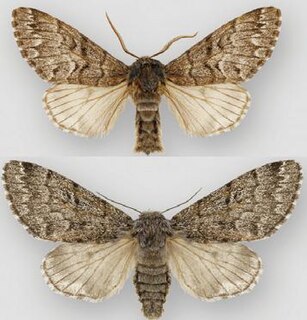
Panthea virginarius, the Cascades panthea, is a moth of the family Noctuidae. It is mainly found west and north of the Great Basin, from the coast of southern California northward to the Queen Charlotte Islands of British Columbia and the Alaskan Panhandle, eastward to central California, northern Nevada, Idaho, north-western Wyoming, western Montana, and south-western Alberta. A disjunct population is found in the Cypress Hills of Alberta and Saskatchewan.

Ctenoplusia albostriata, the eastern streaked plusia, is a moth of the family Noctuidae. It is found in India, Sri Lanka, eastern Asia and the Pacific, including Borneo, Hong Kong, Vietnam, Japan, most of Australia and New Zealand.

Platyja umminia is a species of moth of the family Noctuidae first described by Pieter Cramer in 1780. It is found from the Indo-Australian tropics of China, Japan, India, Sri Lanka, Myanmar to New Guinea and Queensland. It is also present on Guam. Adults have been recorded piercing fruit in Thailand and Guam.
















